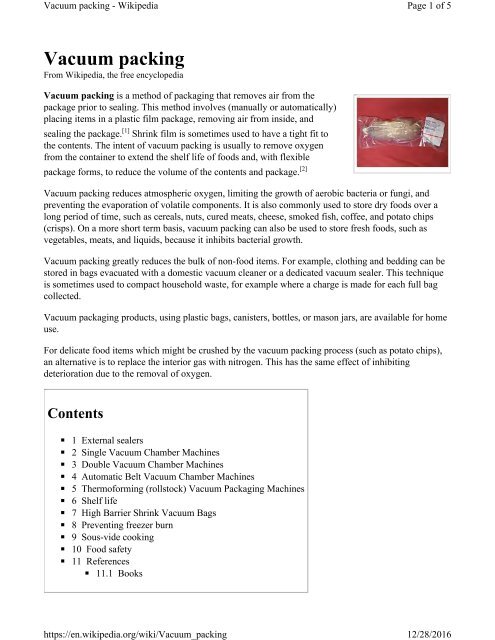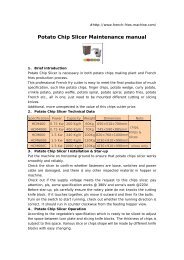Vacuum Packing Machine and Vacuum Packaging MachineTechnology
Foods benefit from vacuum packaging can maintain a vacuum or nitrogen atmosphere and provides a barrier to oxygen. Appropriate vacuum packing prevents food deterioration and results in quality foods with long shelf life. Plastic polymers can be formed into flexible, semi-rigid and rigid packaging. The representative industrial food vacuum packaging machines includes Thermoforming vacuum packaging machine, Modified atmosphere packaging machine, Continuous vacuum packing machine, and Automatic vacuum packaging machine. Vacuum packaging basically refers to a product being placed inside a plastic package. Following this, the air is removed from the packaged and all its open ends are sealed. Food quality and freshness cannot be assured unless vacuum packaging is conducted. A vacuum packaging machine can be used for the packaging of seafood, foodstuff, fruits, meat and vegetables. Since vacuum packaging can ensure the product remains fresh for longer periods of time, it garners the attention of consumers in a better way. This is owing to its visually appealing exterior and what it looks like on the inside. The right vacuum packing machine possesses the ability to enhance production, safeguard products as well as promote brands. Besides prolonging the shelf life of the product, a vacuum packaging machine also ensures the authenticity and original flavor of the products packaged are never compromised with. Investing in a good vacuum packing machine is imperative when it comes to maintaining the steady flow in supply chain demands. Get in touch with us today to learn more about our vacuum packing machine and vacuum packaging machine.
Foods benefit from vacuum packaging can maintain a vacuum or nitrogen atmosphere and provides a barrier to oxygen. Appropriate vacuum packing prevents food deterioration and results in quality foods with long shelf life. Plastic polymers can be formed into flexible, semi-rigid and rigid packaging. The representative industrial food vacuum packaging machines includes Thermoforming vacuum packaging machine, Modified atmosphere packaging machine, Continuous vacuum packing machine, and Automatic vacuum packaging machine.
Vacuum packaging basically refers to a product being placed inside a plastic package. Following this, the air is removed from the packaged and all its open ends are sealed. Food quality and freshness cannot be assured unless vacuum packaging is conducted. A vacuum packaging machine can be used for the packaging of seafood, foodstuff, fruits, meat and vegetables. Since vacuum packaging can ensure the product remains fresh for longer periods of time, it garners the attention of consumers in a better way. This is owing to its visually appealing exterior and what it looks like on the inside. The right vacuum packing machine possesses the ability to enhance production, safeguard products as well as promote brands.
Besides prolonging the shelf life of the product, a vacuum packaging machine also ensures the authenticity and original flavor of the products packaged are never compromised with. Investing in a good vacuum packing machine is imperative when it comes to maintaining the steady flow in supply chain demands.
Get in touch with us today to learn more about our vacuum packing machine and vacuum packaging machine.
Create successful ePaper yourself
Turn your PDF publications into a flip-book with our unique Google optimized e-Paper software.
<strong>Vacuum</strong> packing - Wikipedia<br />
https://en.wikipedia.org/wiki/<strong>Vacuum</strong>_packing<br />
Page 1 of 5<br />
12/28/2016<br />
<strong>Vacuum</strong> packing<br />
From Wikipedia, the free encyclopedia<br />
<strong>Vacuum</strong> packing is a method of packaging that removes air from the<br />
package prior to sealing. This method involves (manually or automatically)<br />
placing items in a plastic film package, removing air from inside, <strong>and</strong><br />
sealing the package. [1] Shrink film is sometimes used to have a tight fit to<br />
the contents. The intent of vacuum packing is usually to remove oxygen<br />
from the container to extend the shelf life of foods <strong>and</strong>, with flexible<br />
package forms, to reduce the volume of the contents <strong>and</strong> package. [2]<br />
<strong>Vacuum</strong> packing reduces atmospheric oxygen, limiting the growth of aerobic bacteria or fungi, <strong>and</strong><br />
preventing the evaporation of volatile components. It is also commonly used to store dry foods over a<br />
long period of time, such as cereals, nuts, cured meats, cheese, smoked fish, coffee, <strong>and</strong> potato chips<br />
(crisps). On a more short term basis, vacuum packing can also be used to store fresh foods, such as<br />
vegetables, meats, <strong>and</strong> liquids, because it inhibits bacterial growth.<br />
<strong>Vacuum</strong> packing greatly reduces the bulk of non-food items. For example, clothing <strong>and</strong> bedding can be<br />
stored in bags evacuated with a domestic vacuum cleaner or a dedicated vacuum sealer. This technique<br />
is sometimes used to compact household waste, for example where a charge is made for each full bag<br />
collected.<br />
<strong>Vacuum</strong> packaging products, using plastic bags, canisters, bottles, or mason jars, are available for home<br />
use.<br />
For delicate food items which might be crushed by the vacuum packing process (such as potato chips),<br />
an alternative is to replace the interior gas with nitrogen. This has the same effect of inhibiting<br />
deterioration due to the removal of oxygen.<br />
Contents<br />
◾ 1 External sealers<br />
◾ 2 Single <strong>Vacuum</strong> Chamber <strong>Machine</strong>s<br />
◾ 3 Double <strong>Vacuum</strong> Chamber <strong>Machine</strong>s<br />
◾ 4 Automatic Belt <strong>Vacuum</strong> Chamber <strong>Machine</strong>s<br />
◾ 5 Thermoforming (rollstock) <strong>Vacuum</strong> <strong>Packaging</strong> <strong>Machine</strong>s<br />
◾ 6 Shelf life<br />
◾ 7 High Barrier Shrink <strong>Vacuum</strong> Bags<br />
◾ 8 Preventing freezer burn<br />
◾ 9 Sous-vide cooking<br />
◾ 10 Food safety<br />
◾ 11 References<br />
◾ 11.1 Books
<strong>Vacuum</strong> packing - Wikipedia<br />
https://en.wikipedia.org/wiki/<strong>Vacuum</strong>_packing<br />
Page 2 of 5<br />
12/28/2016<br />
External sealers<br />
External vacuum sealers involve a bag being attached to the vacuum-sealing machine externally. The<br />
machine will remove the air <strong>and</strong> seal the bag, which is all done outside the machine. A heat sealer is<br />
often used to seal the pack.<br />
Single <strong>Vacuum</strong> Chamber <strong>Machine</strong>s<br />
Single chamber sealers require the entire product to be placed<br />
within the machine. Like external sealers, a plastic bag is<br />
typically used for packaging. Once the product is placed in the<br />
machine, the lid is closed <strong>and</strong> air is removed. Then, there is a<br />
heat seal inside the chamber that will seal the bag, after sealing<br />
the bag the chamber is refilled with air by the automatic opening<br />
of a vent to the outside. This oncoming pressure squeezes all<br />
remaining air in the bag. The lid is then opened <strong>and</strong> the product<br />
removed. Chamber sealers are typically used for low-to-mediumvolume<br />
packaging, <strong>and</strong> also have the capability to vacuum seal<br />
liquids.<br />
This video shows vacuum packaging<br />
of organic rice.<br />
Double <strong>Vacuum</strong> Chamber <strong>Machine</strong>s<br />
Double Chamber <strong>Vacuum</strong> <strong>Packaging</strong><br />
<strong>Machine</strong><br />
Double chamber sealers require the<br />
entire product to be placed in a<br />
plastic bag within the machine.<br />
Once the product is placed in the<br />
machine on the seal bar, the lid is<br />
closed <strong>and</strong> air is removed. Then a<br />
seal bar inside the chamber seals the<br />
product in the bag, after sealing the<br />
bag the chamber is refilled with air<br />
Tabletop <strong>Vacuum</strong><br />
<strong>Packaging</strong> <strong>Machine</strong><br />
by the automatic opening of a vent to the outside. This oncoming<br />
pressure squeezes all remaining air in the bag. The lid is then<br />
opened <strong>and</strong> the product removed. Double chamber sealers are<br />
typically used for medium-volume packaging, <strong>and</strong> also have the capability to vacuum seal liquids. The<br />
lid generally swings from one side to another, increasing production speed over a single chamber model.<br />
Double chamber vacuum packaging machines generally have either spring-weighted lids or fully<br />
automatic lids.<br />
Double chamber vacuum packaging machines are commonly used for:<br />
◾ Fresh Meat<br />
◾ Processed Meat<br />
◾ Cheese (hard <strong>and</strong> soft)<br />
◾ C<strong>and</strong>y & Chocolate<br />
◾ Empty Cans (it's a example of atmospheric pressure)
<strong>Vacuum</strong> packing - Wikipedia<br />
https://en.wikipedia.org/wiki/<strong>Vacuum</strong>_packing<br />
Page 3 of 5<br />
12/28/2016<br />
Automatic Belt <strong>Vacuum</strong> Chamber <strong>Machine</strong>s<br />
Automatic Belt <strong>Vacuum</strong> Chamber<br />
<strong>Machine</strong>. Automatic belt vacuum<br />
chamber machines offer vastly<br />
increased speed <strong>and</strong> automation <strong>and</strong><br />
accommodate large products.<br />
Automatic belt chamber sealers require the entire product to be<br />
placed in a plastic bag or flow wrapped pouch within the<br />
machine. The product travels on the conveyor belt, it is<br />
automatically positioned in the machine on the seal bar, the lid is<br />
closed <strong>and</strong> air is removed. Then a seal bar inside the chamber<br />
seals the product in the bag. After sealing the bag, the chamber is<br />
refilled with air by the automatic opening of a vent to the<br />
outside. This oncoming pressure squeezes all remaining air in the<br />
bag. The lid is then opened <strong>and</strong> the product removed. Automatic<br />
belt vacuum chamber machines are typically used for high-speed<br />
packaging of large items, <strong>and</strong> also have the capability to vacuum<br />
seal liquids. The lid generally travels straight up <strong>and</strong> down.<br />
Automatic belt vacuum chamber packaging machines are<br />
commonly used for:<br />
◾ Fresh Meat (large portions)<br />
◾ Processed Meat<br />
◾ Large Sausage logs<br />
◾ Cheese (hard <strong>and</strong> soft)<br />
Thermoforming (rollstock) <strong>Vacuum</strong> <strong>Packaging</strong> <strong>Machine</strong>s<br />
Thermoform packaging machines are<br />
used in larger production facilities for<br />
vacuum packaging products.<br />
<strong>Vacuum</strong> <strong>Packaging</strong> in large production facilities can be done<br />
with thermoforming machines. These are Form-Fill-Seal style<br />
machines that form the package from rolls of packaging film<br />
(webbing). Products are loaded into the thermoformed pockets,<br />
the top web is laid <strong>and</strong> sealed under a vacuum, producing<br />
vacuum packaged products. Thermoforming can greatly increase<br />
packaging production speed. Thermoformed plastics can be<br />
customized for size, color, clarity, <strong>and</strong> shape to fit products<br />
perfectly, creating a consistent appearance. Some common uses<br />
for Thermoforming in vacuum packaging include:<br />
◾<br />
Fresh & Marinated Meat<br />
◾ Sausage<br />
◾ Cheese<br />
◾ C<strong>and</strong>y / Chocolate<br />
◾ Grain<br />
◾ Grab-<strong>and</strong>-Go Snacks (beef jerky, snack sticks)<br />
◾ Pharmaceutical <strong>and</strong> Medical Products<br />
◾ Coins / Collectables
<strong>Vacuum</strong> packing - Wikipedia<br />
https://en.wikipedia.org/wiki/<strong>Vacuum</strong>_packing<br />
Page 4 of 5<br />
12/28/2016<br />
Shelf life<br />
Depending on the product, the shelf life of vacuum packaged products can exceed normal bagged or<br />
wrapped packages. Beef can last up to six weeks refrigerated, <strong>and</strong> much longer when frozen.<br />
High Barrier Shrink <strong>Vacuum</strong> Bags<br />
The amount of shelf life enhanced by a vacuum bag is dependent on the structure in the material. A<br />
st<strong>and</strong>ard vacuum bag is composed of a PA/PE structure where PA is for puncture resistance <strong>and</strong> PE is<br />
for sealing. The high barrier category includes the usage of more layers focused on the prevention of<br />
oxygen permeability, <strong>and</strong> therefore shelf life protection. There are two materials used in high barrier<br />
structures, polyvinylidene chloride (PVDC) <strong>and</strong> ethylene vinyl alcohol (EVOH). Shelf life indication<br />
can be effectively measured by how many cubic centimeters of oxygen can permeate through 1 square<br />
meter of material over a 24-hour period. A st<strong>and</strong>ard PA/PE bag allows on average 100 cubic<br />
centimeters, PVDC allows on average over 10, <strong>and</strong> EVOH on average 1 cubic centimeter. Multi-layer<br />
structures allow the ability to use strong oxygen-barrier materials for enhanced shelf life protection. The<br />
PremiumPack structure is a good example of EVOH based high barrier shrink material.<br />
Preventing freezer burn<br />
When foods are frozen without preparation, freezer burn can occur. It happens when the surface of the<br />
food is dehydrated, <strong>and</strong> this leads to a dried <strong>and</strong> leathery appearance. Freezer burn also ruins the flavor<br />
<strong>and</strong> texture of foods. <strong>Vacuum</strong> packing reduces freezer burn by preventing the food from exposure to the<br />
cold, dry air.<br />
Sous-vide cooking<br />
<strong>Vacuum</strong> packaging also allows for a special cooking method, sous-vide. Sous-vide, French for under<br />
vacuum, involves poaching food that is vacuum sealed in a plastic bag.<br />
Food safety<br />
In an oxygen-depleted environment, anaerobic bacteria can proliferate, potentially causing food-safety<br />
issues. <strong>Vacuum</strong> packing is often used in combination with other packaging <strong>and</strong> food processing<br />
techniques.<br />
References<br />
1. Perdue, R (2009), "<strong>Vacuum</strong> <strong>Packaging</strong>", in Yam, K L, Encyclopedia of <strong>Packaging</strong> Technology, Wiley<br />
(published 2010), ISBN 978-0-470-08704-6<br />
2. Soroka, W. Illustrated Glossary of <strong>Packaging</strong> Terminology (Second ed.). Institute of <strong>Packaging</strong><br />
Professionals.
<strong>Vacuum</strong> packing - Wikipedia<br />
https://en.wikipedia.org/wiki/<strong>Vacuum</strong>_packing<br />
Page 5 of 5<br />
12/28/2016<br />
Books<br />
◾ Robertson, G.L., Food <strong>Packaging</strong>: Principles <strong>and</strong> Practice, 3rd edition, 2013, ISBN 978-1-4398-<br />
6241-4<br />
◾ Yam, K. L., Encyclopedia of <strong>Packaging</strong> Technology, John Wiley & Sons, 2009, ISBN 978-0-470-<br />
08704-6<br />
Retrieved from "https://en.wikipedia.org/w/index.php?title=<strong>Vacuum</strong>_packing&oldid=749826841"<br />
Categories: Food preservation <strong>Vacuum</strong> <strong>Packaging</strong><br />
◾ This page was last modified on 16 November 2016, at 10:31.<br />
◾ Text is available under the Creative Commons Attribution-ShareAlike License; additional terms<br />
may apply. By using this site, you agree to the Terms of Use <strong>and</strong> Privacy Policy. Wikipedia® is a<br />
registered trademark of the Wikimedia Foundation, Inc., a non-profit organization.





